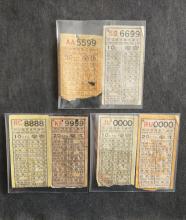70 years ago: Hong Kong's wartime diaries
18 Mar 1945, Barbara Anslow's diary
Submitted by Admin on Sun, 2012-05-06 21:46Book / Document:Date(s) of events described:Sun, 18 Mar 1945Keith Mackie, and Jacquie Anderson's first banns called; and Annie and Rennie's second.
We rehearsed the tots ((for Easter play)) in Annie's room, in front of the Van Der Lely family and 2 on lookers.
Lovely tinned jam pudding in evening. Marie brought eye ointment for me - having styes.
18 Mar 1945, R. E. Jones Wartime diary
Submitted by Admin on Mon, 2015-02-23 00:12Book / Document:Date(s) of events described:Sun, 18 Mar 1945Overcast, drizzly. Cold NE wind.
More firewood arriving, sufficient for 2 months.
Allies have cut road between Frankfurt am Maine and Cologne. Germans evacuated N. Holland.
Wrote little more in my “letter” to Marj.
Wandered around the Camp pm to pass the time away.
18 Mar 1945, Eric MacNider's wartime diary
Submitted by Admin on Thu, 2016-03-17 15:40Book / Document:Date(s) of events described:Sun, 18 Mar 1945Dolo (don't meddle; don't try to improve other people; live your own life well first)
Short
18 Mar 1945, John Charter's wartime journal
Submitted by HK Bill on Tue, 2022-04-19 10:08Book / Document:Date(s) of events described:Sun, 18 Mar 1945The news is good – it always is these days; but my goodness how these Germans hang on and hang on. One cannot but admire their stoicism but I do wish they’d be good fellows and give up trying; it would make things so much easier.
For the last month or so the Japanese have been working like badgers on anti-invasion defences around Stanley. They are busy tunnelling into the hillsides, not much above water level, at numerous points on this peninsula and the adjoining bays and headlands, and blasting goes on day and night. Tunnels command Stanley beach (double tunnels at both ends) and I imagine they will be used as heavy machine gun nests to repel any landing. They are blasting level patches for gun positions too. They are at work on one of the hillsides just above the gaol. It faces to, and commands, the narrow neck of this peninsula at Stanley village and they have constructed a roadway which connects it to the road leading to the fort. They have driven a tunnel into the hill too, behind the gun platform. Mobile guns have been seen, some weeks ago, on their way to the fort. But this particular position seems a very bad and exposed one to my inexperienced eye. It is true that it will command, admirably, the Stanley mound and Mt Parker range of hills but, then, it too is easily commanded from these very ranges and I doubt if the Japs will achieve much in the way of camouflage. The gaol and our blocks will be in the direct line of fire and shells that fall short may do serious damage to civilians. Judging by reports of the fighting on Leyte, the Philippines, Iwajima etc., it seems that the Japanese garrisons usually retire to one final fortified position and there fight it out to the bitter end. We are wondering if they have picked upon Stanley peninsula for the position of their last stand in HK. This place saw the last of the British resistance in Dec 1941. It is the most natural stronghold on the island and it is a place to which forces on the other parts of the island can easily retire if the attack comes from the mainland – as in the case of the Jap attack on this Colony.

